跨文化交际1-1
- 格式:ppt
- 大小:19.19 MB
- 文档页数:71



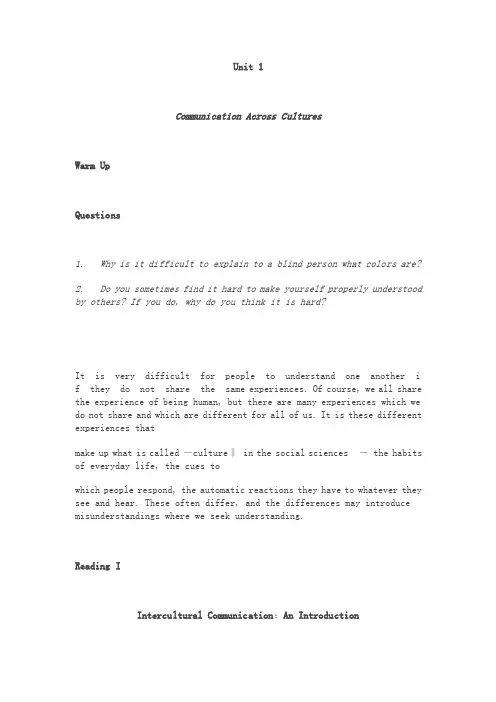
Unit 1Communication Across CulturesWarm UpQuestions1. Why is it difficult to explain to a blind person what colors are?2. Do you sometimes find it hard to make yourself properly understood by others? If you do, why do you think it is hard?It is very difficult for people to understand one another i f they do not share the same experiences. Of course, we all share the experience of being human, but there are many experiences which we do not share and which are different for all of us. It is these different experiences thatmake up what is called ―culture‖ in the social sciences - the habits of everyday life, the cues towhich people respond, the automatic reactions they have to whatever they see and hear. These often differ, and the differences may introduce misunderstandings where we seek understanding.Reading IIntercultural Communication:An IntroductionComprehension questions1. Is it still often the case that“everyone‟s quick to blame the alien”in the contemporary world?This is still powerful in today‘s social and political rhetoric. Forinstance, it is not uncommon intoday‘s society to hear people say that most, if not all, of the social and economic problems arecaused by minorities and immigrants.2. What‟s the difference between today‟s intercultural contact and that of any time in the past?Today‘s intercultural encounters are far more numerous and of greaterimportance than in anytime in history.3. What have made intercultural contact a very common phenomenon in our life today?New technology, in the form of transportation and communication systems, has accelerated intercultural contact; innovative communication systems have encouraged and facilitated cultural interaction; globalization of the economy has brought people together; changes in immigration patterns have also contributed to intercultural encounter.4. How do you understand the sentence“culture is everything and everywhere”?Culture supplies us with the answers to questions about what the world looks like and how we live and communicate within that world. Culture teaches us how to behave in our life from the instant of birth. It is omnipresent.5. What are the major elements that directly influence our perception and communication?The three major socio-cultural elements that directly influence perception and communication are cultural values, worldview (religion), and social organizations (family and state).6. What does one‟s family teach him or her while he or she grows up in it?The family teaches the child what the world looks like and his or her place in that world.7. Why is it impossible to separate our use of language from our culture?Because language is not only a form of preserving culture but also a means of sharing culture. Language is an organized, generally agreed-upon, learned symbol system that is used to represent the experiences within a cultural community.8. What are the nonverbal behaviors that people can attach meaning to?People can attach meaning to nonverbal behaviors such as gestures, postures, facial expressions, eye contact and gaze, touch, etc.9. How can a free, culturally diverse society exist?A free, culturally diverse society can exist only if diversity is permitted to flourish without prejudice and discrimination, both of which harm all members of the society.Discovering Problems: Slim Is Beautiful?Questions for discussionWhich do you think is the mark of beauty, thin or fat? Why is it often said that beauty is in the eye of beholder?One sociologist once said that with the greater influence of American culture across the world, the standard of a beauty is becoming more and more Hollywood-like, characterized by a chiseled chin and a tall, slim figure. One can see such beautiful images in almost any American movie. We Chinese also share the notion that the standard idea of beauty includes being tall, thin, and light skinned. It seems that with the process of globalization, eastern and western beauties look more and more alike.But we have to remember that the definition of beauty differs from culture to culture. For example, Hispanic standards of female beauty are to have big hips, a moderate tan, and a short height. As is described in the article, in southeastern Nigeria, Coca-Cola-bottle voluptuousness is celebrated and ample backsides and bosoms are considered ideals of female beauty.What‘s more, the ideal standard of beauty varies from time to time. For instance, during timesof famine, the ideal standard of beauty for women is a much larger body size. Larger size and more body fat may reflect one‘s status; for it suggests that the person is well fed and healthy. Thinness then would reflect malnutrition. However, during times of plenty, plumpness is not a reflection ofstatus. People may easily associate fatness with hypertension, heart disease or other potential diseases. Likewise, during eras in which lower-class labors had to toil predominantly outside for hours a day, tanned skin was an indication of lower status, and therefore the ideal standard of female beauty was very pale skin; women during those times actually used a lot of white powdered cosmetics to exaggerate the paleness of their skin. Now, however, tan is a reflection of having more leisure time spent on seashores instead of working in an office all the time, and therefore it may suggest higher status, so women strive for darker skin tones.It is true that beauty is in the eye of the beholder because people of different cultures and in different situations may have different ideas about what is beautiful and what is not.Group WorkFirst share with your group member whatever experiences you have had in communication events that can be considered as intercultural. Then work together to decide whether each of the following cases of communication is possibly intercultural or not and, if it is, to what extent it is intercultural. Try to place all the cases along a continuum of interculturalness, from the most intercultural to the least intercultural.All the cases may seem to be intercultural but they differ in the extent to which they are intercultural. However it may be very difficult for us to place all these cases along a continuum of interculturalness from the most intercultural to the least intercultural, for many other factors haveto be taken into consideration if we have to decide which is more intercultural than another. For instance, whether communication between a male manager and a female secretary is intercultural or not and, if it is, how intercultural it may be, may depend on the cultural and social backgrounds of the two persons. If they are from drastically different cultures, communication between them is surely intercultural and may be very intercultural. If they are from the same culture, communication between them may be little intercultural.The following is tentatively suggested for measuringthe interculturalness of the cases of communication, and the cases are presented from the most intercultural to the least intercultural:Communication between a Chinese university student and an American professor; Communication between a Canadian girl and a South African boy;Communication between a first-generation Chinese American and third generation one; Communication between a businessperson from Hong Kong and an artist from Xian; Communication between a teenager from Beijing and a teenager from Tibet;Communication between a father who is a farmer all his life and his son who works as an engineer;Communication between a software technician and a fisherman;Communication between a male manager and a female secretary (supposing they are of the similar cultural and social backgrounds) .DebateThe class is to be divided into two groups and debate on the two different views mentioned in thefollowing on intercultural communication. State your point of view clearly and support your argument with convincing and substantive evidence.Pro: People are people; more interactions would lead to grea ter understanding of each other.(Commonality precedes)Con: People are shaped by different environments they find themselves in, therefore, the difference overrides. (Differences precedes)Possible Arguments for Pro:1. Human beings tend to draw close to one another by their common nature. We all share the common basic needs.2. Rapid expansion of worldwide transportation and communication networks have made it far easier than ever before for people throughout the world to contact with one another.3. The process of globalization may reduce the regional differences between people all over the world. We are all members of the ―global village‖.4. Economic interdependence in today‘s world requires people of different countries to interact onan unprecedented scale, and more interaction will result in more similarity among people.5. More and more people from various cultures have to work and live together and they will adapt to each other to such an extent that cultural differences between them may no longer matter.Possible Arguments for Con:1. People throughout the world may be similar in many aspects, but differences in habits and customs keep them apart.2. Though the basic human needs are universally the same, people all over the world satisfy their basic common human needs in different ways.3. As our society is becoming more and more diversified, differences between people tend to grow larger in some aspects.4. It is differences between people that underlie the necessity of communication, and it does not follow that communication which may increase the possibility of understanding between people will always reduce differences.5. People nowadays are more likely to try to maintain their unique cultural identities when they find themselves living closely with people of other cultures.From the two seemingly opposite viewpoints, we can learn something that we should keep in mind when we are involved in intercultural communication. First, all human beings share some common heritages that link us to one another. To some extent, people throughout the world are pretty much alike in many aspects, and that has formed the very basis on which it is possible for people of various cultures to communicate. However, what we have to realize is that there are also vast differences between people from various cultural groups. To really understand a person whose cultural background is different from yours can be very difficult, for both you and that person maybe subconsciously influenced by each one‘s own cultural upbringing. In a sense, what we should doin intercultural communication is to treat people of other cultures both as the same with and as different from us.Reading IIThe Challenge of GlobalizationComprehension questions1. Why does the author say that our understanding of the world has changed?Many things, such as political changes and technological advances, have changed the world very rapidly. In the past most human beings were born, lived, and died within a limited geographical area, never encountering people of other cultural backgrounds. Such an existence, however, no longer prevails in the world. Thus, all people are faced with the challenge of understanding this changed and still fast changing world in which we live.2. What a“global village”is like?As our world shrinks and its inhabitants become interdependent, people from remote cultures increasingly come into contact on a daily basis. In a ―global village‖, members of once isolated groups of people have to communicate with members of other cultural groups. Those people maylive thousands of miles away or right next door to each other.3. What is considered as the major driving force of the post-1945 globalization?Technology, particularly telecommunications and computers are considered to be the major driving force.4. What does the author mean by saying that“the…global‟may be more local than the…local‟”?The increasing global mobility of people and the impact of new electronic media on human communications make the world seem smaller. We maycommunicate more with people of other countries than with our neighbors, and we may be more informed of the international events than of the local events. In this sense, ―the ‗global‘ may be more local than the‗local‘‖.5. Why is it important for businesspeople to know diverse cultures in the world?Effective communication may be the most important competitive advantage that firms have tomeet diverse customer needs on a global basis. Succeeding in the global market today requires the ability to communicate sensitively with people from other cultures, a sensitivity that is based on an understanding of cross-cultural differences.6. What are the serious problems that countries throughout the world are confronted with?Countries throughout the world are confronted with serious problems such as volatile international economy, shrinking resources, mounting environmental contamination, and epidemics that know no boundaries.7. What implications can we draw from the case of Michael Fay?This case shows that in a world of international interdependence, the ability to understand and communicate effectively with people from other cultures takes on extreme urgency. If we are unaware of the significant role culture plays in communication, we may place the blame for communication failure on people of other cultures.8. What attitudes are favored by the author towards globalization?Globalization, for better or for worse, has changed the world greatly. Whether we like it or not, globalization is all but unstoppable. It is already here to stay. It is both a fact and an opportunity. The challenges are not insurmountable. Solutions exist, and are waiting to be identified and implemented. From a globalistic point of view, there is hope and faith in humanity.WritingRead the following and then try to write a short essay on what one has to learn to get prepared for working and living in a new cultural environment.There seems to be so much that one can do to get oneself well prepared for working and living in a new cultural environment. Apart from what is mentioned in the pass age, the following may be what a person in Anna‘s situation should also try to do:1. Learning the language that is used in the new cultural environment.2. Learning about the history and present social situation of the area or the country.3. Learning about the dominant religious belief and some important social customs.4. Learning about the cultural uses of nonverbal means including time and space for communication.5. Learning to look at things and people in new perspectives that are different from what one is accustomed to.6. Developing a more tolerant attitude toward any unfamiliar phenomena.7. Becoming aware that problems and misunderstandings a re inevitable in intercultural communication.8. Learning about how foreigners are usually perceived and treated by the local people.Identifying Difference: How We Address Each OtherQuestions for discussionHow do you address a friend from an English-speaking country? And how should we do it if he or she knows our culture very well or if we speak Chinese to each other?Usually we can address a friend from an English-speaking country by his/her first name withoutmentioning his/her surname or title out of respect for his/h er culture. Because people from English-speaking countries attach great importance to casualness in addressing each other in order to form a relatively intimate and equal relationship. But if he or she knows our culture very well or if we speak Chinese to each other, we can address him/her in the Chinese way. Just as the old sayinggoes, ―When in Rome, do as the Romans do‖, it‘s better for our friend to learn more about andbecome better acquainted with the Chinese culture. In this way, when addressing him/her, we can add ―xiao‖ (young) or ―lao‖ (aged) before his/her family name according to his/her age so as to create an amicable atmosphere. We can also address him/her by using his/her title in a humorous way,or by inventing some nickname for him or her in either English or Chinese, depending on the degree of intimacy.SurveyConduct a survey among some Chinese students to find how much they know about the possible cultural differences between Chinese andEnglish-speaking people in the speech behaviors listed below.Speech behaviorChina English-speaking countries Greeting When greeting each other, the Chinese often begin with ―Have you eaten?‖, ―Where areyougoing?‖, ―What are youdoing?‖, ―Long time no see.‖ and so on.People from English-speakingcountries usuallysay ―Hello.‖―Good morning/afternoon/evening‖ ―Nice to meet you./Glad to see you.‖ or ―How doyou do?‖Apologizi ng Chinese people seem to apologize less often than English-speaking people. The Chinese apologize only when they think it is about something thatreally matters.People from English-speaking countries often apologize intheir daily life even forthe most trivial things.Making requests Chinese people tend to make requests in indirect ways, especially when the p eoplePeople from English-speaking countries tend tomake requests directly andopenly.involved are not on int imate terms with one another.Expressin g gratitude Chinese people often express their gratitude not just bywhat they say, but also by whatthey do and what they give toothers who have done them a favor.People from English-speakingcountries tend to show theirgratitude more verballyto others who have helpedthem.Expressin g disapprov al Chinese people are reluctant toexpress their disproval openlyfor fear of making others loseface. If they have to expressdisapproval, they often prefer todo it in a very indirect way.People from English-speakingcountries are more likely toexpress their disapproval freely and directly.Leave-tak ing Chinese people tend to excusethemselves by claiming that theothers must be tired or busy, etc,using the expressions that imputethe motive of tiredness or business to the otherparty when parting.People from English-speakingcountries would usually findreasons to part related tothemselves rather than to others.Intercultural InsightExplorationTry to describe and explain the possible similar experiences in your use of English as a foreign language in communicating with native speakers.What a student tells us below can further illustrate the po int that how we communicate appropriately in intercultural encounters may not be as simple as we tend to assume:I remember in the first class of oral English when I was a freshman at university, we students habitually addressed our amiable foreign teacher as ―teacher‖ as we did to the other Chinese teachers. But he asked us to call him by his first name instead. Since he seemed morethan fifty years old we were embarrassed but gradually we learned that was the suitable way to address a teacher in the United States, for teachers in the United States generally prefer to be seen as equal and like a friend to their students. However, when I was already a junior, to our great surprise, one of our foreign teachers who taught us intensive reading told us that hepreferred to be called by us as ―Professor White‖or ―Doctor White‖. The reason was simplythat he wanted to be properly respected in China.Translation纵观历史,我们可以清楚地看到,人们由于彼此所处地域、意识形态、容貌服饰和行为举止上存在的差异,而长久无法互相理解、无法和睦相处。
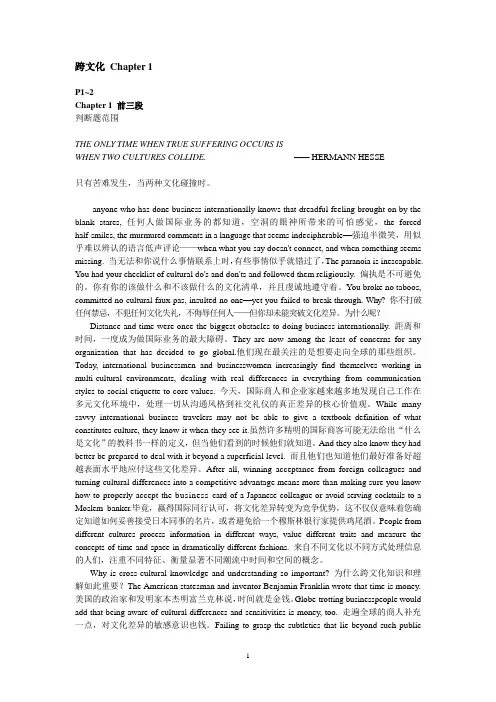
跨文化Chapter 1P1~2Chapter 1 前三段判断题范围THE ONLY TIME WHEN TRUE SUFFERING OCCURS ISWHEN TWO CULTURES COLLIDE. —— HERMANN HESSE只有苦难发生,当两种文化碰撞时。
anyone who has done business internationally knows that dreadful feeling brought on by the blank stares,任何人做国际业务的都知道,空洞的眼神所带来的可怕感觉,the forced half-smiles, the murmured comments in a language that seems indecipherable—强迫半微笑,用似乎难以辨认的语言低声评论——when what you say doesn't connect, and when something seems missing.当无法和你说什么事情联系上时,有些事情似乎就错过了,The paranoia is inescapable. You had your checklist of cultural do's and don'ts and followed them religiously.偏执是不可避免的。
你有你的该做什么和不该做什么的文化清单,并且虔诚地遵守着。
You broke no taboos, committed no cultural faux pas, insulted no one—yet you failed to break through. Why?你不打破任何禁忌,不犯任何文化失礼,不侮辱任何人——但你却未能突破文化差异。
为什么呢?Distance and time were once the biggest obstacles to doing business internationally.距离和时间,一度成为做国际业务的最大障碍。
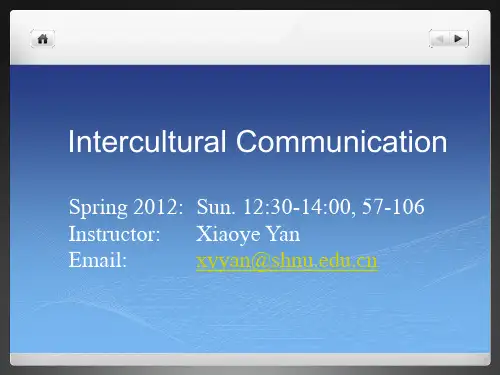
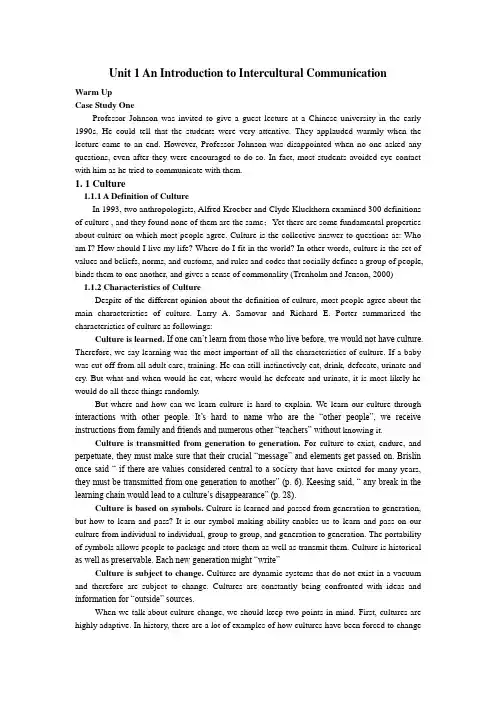
Unit 1 An Introduction to Intercultural CommunicationWarm UpCase Study OneProfessor Johnson was invited to give a guest lecture at a Chinese university in the early 1990s. He could tell that the students were very attentive. They applauded warmly when the lecture came to an end. However, Professor Johnson was disappointed when no one asked any questions, even after they were encouraged to do so. In fact, most students avoided eye contact with him as he tried to communicate with them.1. 1 Culture1.1.1 A Definition of CultureIn 1993, two anthropologists, Alfred Kroeber and Clyde Kluckhorn examined 300 definitions of culture , and they found none of them are the same;Yet there are some fundamental properties about culture on which most people agree. Culture is the collective answer to questions as: Who am I? How should I live my life? Where do I fit in the world? In other words, culture is the set of values and beliefs, norms, and customs, and rules and codes that socially defines a group of people, binds them to one another, and gives a sense of commonality (Trenholm and Jenson, 2000)1.1.2 Characteristics of CultureDespite of the different opinion about the definition of culture, most people agree about the main characteristics of culture. Larry A. Samovar and Richard E. Porter summarized the characteristics of culture as followings:Culture is learned.If one can’t learn from those who live before, we would not have culture. Therefore, we say learning was the most important of all the characteristics of culture. If a baby was cut off from all adult care, training. He can still instinctively eat, drink, defecate, urinate and cry. But what and when would he eat, where would he defecate and urinate, it is most likely he would do all these things randomly.But where and how can we learn culture is hard to explain. We learn our culture through interactions with other people. It’s hard to name who are the “other people”, we receive instructions from family and friends and numerous other “teachers” without knowing it.Culture is transmitted from generation to generation.For culture to exist, endure, and perpetuate, they must make sure that their crucial “message” and elements get passed on. Brislin once said “ if there are values considered central to a soc iety that have existed for many years, they must be transmitted from one generation to another” (p. 6). Keesing said, “ any break in the learning chain would lead to a culture’s disappearance” (p. 28).Culture is based on symbols. Culture is learned and passed from generation to generation, but how to learn and pass? It is our symbol-making ability enables us to learn and pass on our culture from individual to individual, group to group, and generation to generation. The portability of symbols allows people to package and store them as well as transmit them. Culture is historical as well as preservable. Each new generation might “write”Culture is subject to change. Cultures are dynamic systems that do not exist in a vacuum and therefore are subject to change. Cultures are constantly being confronted with ideas and information for “outside” sources.When we talk about culture change, we should keep two points in mind. First, cultures are highly adaptive. In history, there are a lot of examples of how cultures have been forced to changetheir course because of natural disasters, wars, and etc. Second, although many aspects of culture are subject to change, the deep structure of a culture resists major alterations. Barnlund clearly make this point when he writes: “The spread of Buddhism, Islam, Christianity, and Confucianism did not homogenize the societies they enveloped. It was usually the other way around: Societies insisted on adapting the religions to their own cultural traditions” (p.192)Culture is ethnocentric. The important tie between ethnocentrism and communication can be seen in the definition of the term “ ethnocentrism”. Summer defined it as “ the technical name for the view of things in which one’s own group is the center of everything, and all othe rs are scaled and rated with reference to it” (p.13) Keesing summarized the power and impact of ethnocentrism “ Nearly always the folklore of a people includes myths of origin which give priority to themselves, and place the stamp of supernatural approval upon their particular customs” (p. 45).1.1.3 Cultural SyndromesSome cultures are relatively simple, and other cultures are relatively complex. The organizing theme of the syndrome is complexity. Harry C. Triandis classified culture syndromes according to the following categories.TightnessTight cultures have many rules, norms, and ideas about what is correct behaviour in each situation; loose cultures have fewer rules and norms. In tight cultures, people can not tolerate when others do not follow the norms of the society, and may even kill those who do not behave as is expected, but in loose cultures people are tolerant of many difference from normative behaviours.Thus, conformity is high in tight cultures. Eg. In Japan, which is a tight culture, people are sometimes criticized for minor deviations from norms. Most Japanese live in fear that they will not act properly. (Iwao, 1993).Tightness is more likely in the following situations:1. The culture is relatively isolated from other cultures, so that consensus about what is proper behaviour can develop.2.The culture is more likely to be tight where people are highly interdependent.3. Tightness is more likely to occur where there is a high population density.Individualism and CollectivismIndividualism stands for a society in which the ties between individuals are loose: everyone is expected to look after himself or herself and his or her immediate family only.”Collectivism “stands for a society in which people from birth onwards are integrated into strong cohesive ingroups, which throughout people’s lifetime continue to protect them in exchange for unquestioning loyalty.”Individualistic cultures like USA and France are more self-centred and emphasize mostly on their individual goals. People from individualistic cultures tend to think only of themselves as individuals and as "I" distinctive from other people. They make just a little different between ingroup and outgroup communication . They prefer clarity in their conversations to communicate more effectively and come in general directly to the point like the Finns and Americans are doing. Vertical and Horizontal CulturesVertical cultures take hierarchy as a natural state. In this culture, people are different from each other. The people who are at the top “naturally” have more power and privileges than those atthe bottom of the hierarchy. In horizontal culture, people are basically similar, equality is a given state.Active-Passive CulturesThis way of classifying culture is from the perspective of attitude towards nature. In active cultures people try to change the nature to fit them; in passive cultures people try to change themselves to fit into the nature. (Diaz-Guerrero, 1979). The active cultures are more competitive, and emphasize self-fulfillment; in passive cultures , people are more cooperative, emphasize the experience of living, and getting along with other people are their concerns.Universalism-ParticularismUniversalism and particularism are standards that may guide behavior of persons or of whole cultures. Universalism implies that correct behavior can be defined and always applies, while particularism suggests that relationships come ahead of abstract social codes. In universalist culture people try to treat others on the basis of universal criteria regardless of who they are in sex, age, race, etc.; in particularist cultures people treat others on the basis of who the other person is.In universalist cultures, people’s focus is more on rules than on relationships; while in particulist culture, people’s focus is more on relationships than on rules. A univeralist is preparing for “rational”, while a particulist is preparing for “personal”.Take the case of trying to cross the street at the red light. In a universalist culture, you will still be frowned at even if there is no traffic. In a particularist culture, it is likely to be OK with one if it is his/her brothers or friends that violate the traffic rule. These people are not "citizens", but their "friends" or "brothers".Diffuse-SpecificThis dimension measures how far people get involved with other's life space. Take a research group as an example. In specific-oriented cultures, the project leader would segregate out the task relationship he/she has with a subordinate, and insulates this "work relationship" from other dealings. Therefore, the leader's authority only reaches where his/her work relationship with the subordinate is defined, and each area in which the two persons encounter each other is considered apart from the other. Work and life are sharply separated in specific-oriented cultures life the U.S. In diffuse cultures, however, life space and every level of personality tends to permeate ALL others. For example, a teacher would be treated by the student not only as an instructor in the classroom, but also has certain influence on the student's home life. The boss-subordinate relationship usually does not stop only in the office; the boss is likely to have a say in other aspects of his/her employee's personal life.Affective - NeutralIn relationships between people, reason and emotion both play a role. Which of these dominates will depend upon whether we are affective, that is we show our emotions, in which case we probably get an emotional response in return, or whether we are emotionally neutral in our approach. Members of cultures which are affectively neutral do not express their feelings but keep them carefully controlled and subdued. In contrast, in cultures high in affectivity, people show their feelings plainly by laughing, smiling, grimacing, scowling and gesturing; they attempt to find immediate outlets for their feelings.Neutral cultures are not necessarily cold or unfeeling, nor are they emotionally constipated or repressed. In fact, the amount of emotion we show is often the result of convention. Achievement vs. AscriptionThis dimension is about how status is accorded to people in different cultures. The contrast between an achievement culture and an ascriptive culture is not difficult to understand. Achievement means that people are judged on what they have accomplished and on their record. Ascription means that status is attributed to you by things like birth, kinship, gender, age, interpersonal connections, or educational record. The former kind of status is called achieved status and the latter ascribed status. Achieved status refers to doing; ascribed status refers to being. Take a look at the difference from another angle. Achievement-oriented societies or organizations justify their hierarchies by claiming that senior people have "achieved more." Inascription-oriented cultures, however, hierarchies are justified by "power-to-get-things-done." Here are some examples.Let's assume that you are being interviewed by your potential boss and he/she is interested in knowing more about your educational background. In an achievement culture, the first question is likely to be "What did you study?" In contrast, this question will more likely be "Where did you study?" and only if it was a lousy university or one they do not recognize will this ascriptive interviewer asks what you studied.In addition to sampling different attributes, members of different cultures give different weights to the attributes that they sample. One can identify many more syndromes.1.2 Communication1.2.1 A Definition of CommunicationAlthough communication has been written for about 25 centuries, there is still disagreement about how to define it. In 1972, Frank Dance and Karl Larson surveyed the field for definition of communication. They found 126. And we can list some.Communication is the discriminatory response of an organism to a stimulus.Communication… is an “effort after meaning,” a creative act initiated by man in which he seeks to discriminate and organize cues so as to orient himself in his environment and satisfy his changing needs.Speech communication is a human process through which we make sense out of the world and share that sense with others.Communication: the transmission of information, ideas, emotions, skills, etc. by the use of symbols…Communication is a process by which a source transmits a message to a receiver through some channel.Communication is a transactional process and we develop a mutually dependent relationship by exchanging symbols. First, communication is a process. And it is symbolic, continuous, systematic, irreversible, and unrepeatable.1.2.2 The Prosperities of CommunicationIn last section, communication was defined. The definition reflects how we define communication. But there are numerous ways this word communication can be defined. Dance and Larson (1976) list over 125 definitions of this term. Yet despite these different definitions, most theorists agree on the properties of communication. Neuliep (2000) provides a summary of these, along with eight definitions of communication.1. Communication is a process. “Communication theory reflects a process point of view…you cannot talk about the beginning or the end of communication…”(Berlo)2. Communication is dynamic. “Communication is a transaction among symbol users in which meanings are dynamic, changing as a function of earlier usages and of changes in perceptions and metaperceptions. Common to both meanings is the notion that communication is time-bound and irreversible.” (Bowers and Bradac)3. Communication is interactive/ transactive. “Communication occurs when two or more people interact through the exchange of messages.” (Goss)4. Communication is symbolic. “… all the symbols of the mind, together with the means of conveying them through space and preserving them in time.” (Cooley)5. Communication is intentional. “…communication has as its central interest those behavioral situations in which source transmits a message to a receivers with conscious intent to affect the latter’s behavior.” (Miller)6. Communication is contextual. “Communication always and inevitably occurs within some context.” (Fisher)7. Communication is ubiquitous. “…communication is the discriminatory response of an organism to a stimulus.” (Stevens)8. Communication is cultural. “…culture is communication…communication is culture.”(Hall)Case Study TwoMing Li is a Chinese scholar in agriculture. He had been co-operating with Hank, an American professor on a project. And Hank had been to China twice for the project. And Ming Li arranged everything for him, including accommodation, having his students accompany him whenever he needed to do something. Frequently Ming Li invited him to home or restaurants for meals. And every meal was like a feast. Hank was very grateful, but told Ming Li several time that he could take care of himself.Eventually, Ming Li went to the United States to work with Hank for a period of time. Hank picked him up at the airport and took him directly to his temporary accommodations. Saying that he would take Ming Li out for dinner some day and went back home.Ming Li did not speak much English and he felt like a stranger in U.S. and he expected more from Hank. Hank did take him out for dinner in a nice restaurant one evening and invited him to his home once. But Ming Li had to arranged everything himself from shopping to traveling. Neither Hank nor his students accompanied him. He was very disappointed and hurt by Hank, thinking Hank should at least return the favor he had done to him.In fact, Ming Li was so upset that his working relationship with Hank suffered. Hank noticed the change but did not know where the tension came from.Questions:1.What is hospitality in Chinese perspective?2.Having Ming Li’s students accompany him everywhere, does Hank feel verycomfortable?3.Was Hank not very grateful and hospitable?1.3 Intercultural Communication1.3.1 What is Intercultural Communication?According to Neuliep (2003), intercultural communication occurs whenever a minimum of two persons from different cultures or microcultures come together and exchange verbal and nonverbal symbols. Microcultures are groups of people that exist within the broader rules andFood.dress.music. visual arts. Drama. craftsnguagecelebrations.gamescourtesy. Contextual conversational patterns. Concept of time. Personalspace. Rules of conduct. Facial expressions. Nonverbal communication.Body language. Touching. Eye contact. Patterns of handling emotions.Notions of modesty. Concept of beauty. Courtship practices.Relationships to animals. Notions of leadship. Tempo of work. Conceptsof food. Ideals of childrearing. Theory of disease. Social interaction rate.Nature of friendships. Tone of voice. Attitudes toward elders. Concept ofcleanliness. Notions of adolescence. Patterns of group decision-making.Definition of insanity. Preference for competition or cooperation.Tolerance … and so forthSurface CultureAbove sea levelEmotional Load:relatively low guidelines of the dominant culture, but are distinct in some way: racially, linguistically, occupation, age, or sexual orientation. Often microcultural groups have histories that differ from the dominant cultural group and are subordinate in some way.Intercultural communication, like all communication, is contextual. A context is a combination of factors--- situation, setting, circumstance, the people involved, the relationship of those people, and so on. In short, context is the overall framework within which communication takes place.1.3.2 A Narrative Approach to Intercultural CommunicationThere are numerous approaches to the study of intercultural communication--- all of which have their strengths and weaknesses. Based on our own intercultural living experiences, we are convinced that the most effective and insightful approach is the narrative approach.Scholars often discuss culture in terns of an iceberg metaphor. What we see in any culture is only the tip of the iceberg. Yet, effective communication occurs only when we begin to understand what is below the water level.The Iceberg Concept of CultureLike an iceberg, nine-tenths of culture is below the surface.Another metaphor compares culture to a theatrical production. You see what is on stage, but you don ’t see all the activity backage. It is the backstage activity that enables the action on stage to be effective.We suggest a narrative approach to the study of intercultural communication. We are the stories we tell. We make sense out of others and ourselves through story. As storytellers, our values, emotions, and aesthetic considerations ground our beliefs and behaviors.A key concept in the narrative approach is the concept of narrative itself. Fisher indicated “By ‘narration’, I mean symbolic actions---- words and/or deeds--- that have sequence and meaning for those who live, create, or interpret them”(p.58), he also states it “ There is no genre, including technical communication, that is not an episode in the story of life” (p. 347).Thus, listening to a class lecture, talking with your friends, listening to a political speech or the evening news, reading a book--- all consist of your hearing and shaping narratives. If story is a universal medium, then story is the key to our understanding of others from cultures unlike our own.Because our lives are experienced through narratives, some standard for determining which stories to believe and which to disregard is essential. This standard is narrative rationality. It is different from the traditional one in which most Westerners have been trained. Traditional standards of rationality ask questions such as:1. Are the claims supported by the facts?2. Have all relevant facts been considered?3. Are the arguments internally consistent?4. Does the reasoning used conform to the tests of formal and informal logic?In contrast, narrative rationality is concerned with the principle of coherence and fidelity. Coherence refers to the internal consistency of the narrative and asks such questions as:1.Do the elements of the story flow smoothly?2.Is the story congruent with the stories that seem related to it?3.Are the characters in the story believable?Fidelity, the second principle of narrative rationality, concerns truthfulness or reliability of the story. Stories with a high degree of fidelity “ring true” to the listener. When the elements of a story “represent accurate assertions about social reality” (Fisher, 1987, p.105), they have fidelity. Fisher proposes that we assess narrative fidelity through the logic of good reasons. If a narrative possesses fidelity, it constitutes good reasons for a person to hold a certain belief or act in a certain way. The logic of good reasons enables a person to judge the worth of stories by presenting the listener with a set of values that appeal to her or act in a certain way. The logic of good reasons enables a person to judge the worth of stories by presenting the listener with a set of values that appeal to her or him and form warrants for accepting or rejecting a certain story.The logic of good reasons consists of asking two sets of questions. The first set constitutes a logic of reasons:1. Are the statements that claim to be factual in the narrative really factual?2. Have any relevant facts been omitted from the narrative or distorted in its telling?3. What are the patterns of reasoning that exist in the narrative?4. How relevant are the arguments in the story to any decision the listener may make?5. How well does the narrative address the important and significant issues of this case? Assignment:Terms: culture , Individualism and Collectivism, communication, intercultural communication, Questions:1.What are characteristic of culture?2.What are properties of communication/3.How do Harry C. Triandis clarify Cultural Syndromes4. How do you understand The Iceberg Concept of Culture。
![跨文化交际课123[1]](https://uimg.taocdn.com/0e506a1c59eef8c75fbfb331.webp)

跨文化交际概念范文跨文化交际是指不同文化背景下的个人、团体或社区之间进行沟通与交流的过程。
在全球化的背景下,跨文化交际变得越来越重要,因为全球各地人们之间的交流和合作变得越来越频繁。
跨文化交际可以促进相互了解和尊重,消除误解和偏见,构建和谐的人际关系和国际关系。
在跨文化交际中,人们面临许多挑战和障碍。
语言差异是其中最大的障碍之一、语言不仅包括词汇和语法,还包括语速、语调和表达方式等。
不同语言之间的语言结构和表达方式的差异可能导致误解和沟通障碍。
此外,文化差异也是一个重要的问题。
不同的文化具有不同的价值观、信仰、行为准则和社会习俗,这些差异可能导致误解和冲突。
还有非语言交际,比如眼神接触、肢体语言和空间观念等,也可能因为不同文化之间的差异而产生误解。
在跨文化交际中,还需要注意一些特定的问题和技巧。
首先,在使用语言时要注意语言的简洁性和明确性。
为了避免误解和困惑,我们应该尽量使用简单明了的语言,避免使用复杂的词汇和句子结构。
其次,在使用非语言交际时要注意肢体语言和空间观念的差异。
不同文化对于肢体语言和身体接触的态度可能有很大差异,因此我们在与不同文化的人进行交流时应该注意这些差异,以避免造成冲突和误解。
最后,在跨文化交际中要注重尊重和礼貌。
尊重对方的文化和习俗是建立良好跨文化交际的基础,我们应该学会尊重和接受不同文化的差异。
总之,跨文化交际是一个复杂而关键的概念。
在全球化的时代,跨文化交际对于人们的个人和职业发展变得越来越重要。
通过了解和尊重不同文化之间的差异,通过培养文化敏感性和跨文化技巧,我们可以促进相互了解、消除误解,建立和谐的人际关系和国际交流。
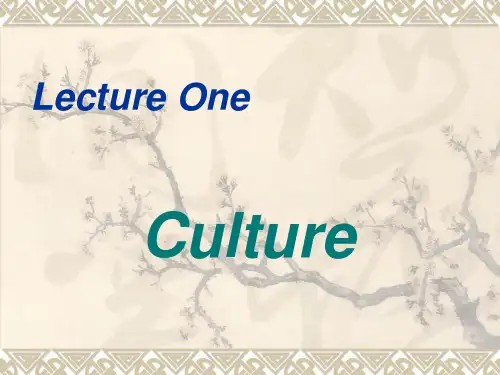
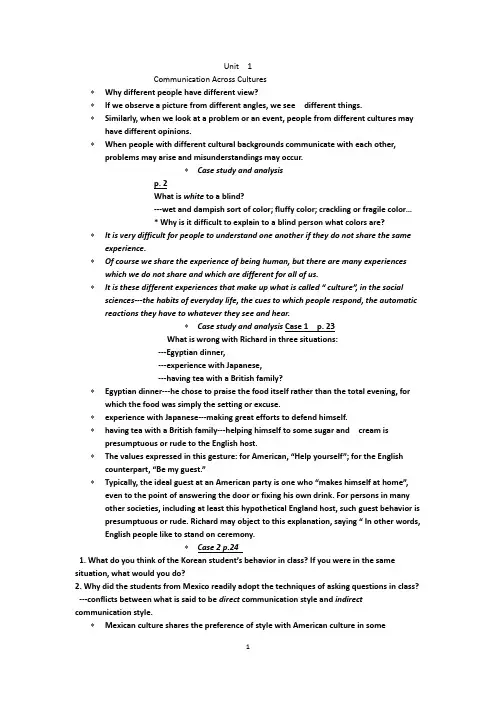
对跨文化交际的理解与认识一、引言跨文化交际是指不同文化背景的人之间进行交流和沟通的过程。
在当今全球化的背景下,跨文化交际已经成为一个日益重要的话题。
跨文化交际不仅涉及到个人生活中的各个方面,也是企业、政府和国际组织等机构开展国际合作的重要基础。
本文将从多个角度对跨文化交际进行分析和探讨。
二、跨文化交际的定义1. 跨文化交际的概念跨文化交际是指在不同国家或地区,使用不同语言和符号系统的人之间进行信息传递、意见交流以及价值观念传递等活动。
2. 跨文化交际的特点(1)多元性:涉及到多种语言、多种符号系统、多种价值观念等。
(2)复杂性:涉及到社会制度、政治体制、历史背景等因素。
(3)动态性:随着时代发展和社会变革,跨文化交际也在不断变革。
三、影响跨文化交际的因素1. 语言差异语言是人类最重要的沟通工具之一,但不同语言之间存在差异。
这些差异可能包括语音、语法、词汇、文化背景等方面。
2. 文化差异不同的文化背景会影响人们的价值观念、信仰、习惯和行为方式等方面。
这些差异可能会导致误解和沟通障碍。
3. 社会制度和政治体制社会制度和政治体制也会影响跨文化交际。
例如,在某些国家或地区,政府对媒体进行严格控制,这可能会影响信息传递和意见交流。
4. 历史背景历史背景也是影响跨文化交际的因素之一。
在历史上曾经发生的事件和经历可能会影响人们对某些事物的看法和态度。
四、跨文化交际中需要注意的问题1. 尊重他人文化在跨文化交际中,尊重他人文化是非常重要的。
我们应该了解对方的价值观念、信仰、习惯等,并尽量避免冒犯他人。
2. 学习他人语言学习他人语言可以帮助我们更好地理解对方,并且能够更好地进行沟通和交流。
3. 了解对方文化背景了解对方文化背景可以帮助我们更好地理解对方的行为和思维方式,并且能够更好地进行交流和合作。
4. 避免刻板印象在跨文化交际中,我们应该避免刻板印象,不应该根据个别人或事件来评价整个文化。
5. 注意语言表达方式在跨文化交际中,语言表达方式非常重要。